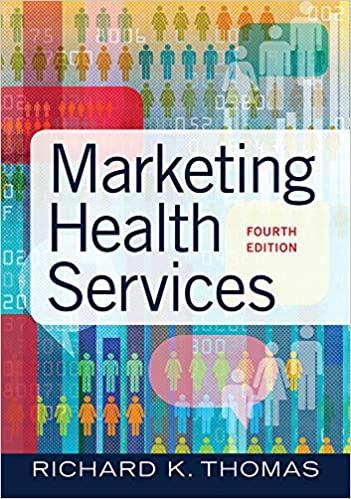SouthCoast Institute, a rehabilitation hospital, perceived an opportunity to expand its outpatient capabilities. Among SouthCoasts options was
Question:
SouthCoast Institute, a rehabilitation hospital, perceived an opportunity to expand its outpatient capabilities. Among SouthCoast’s options was to develop an aqua therapy program that would supplement its existing inpatient services and allow it to serve a wider range of customers on an outpatient basis. The hospital’s staff recognized the need to engage in the marketing planning process to successfully design, launch, and evaluate this new service.
Step 1
In organizing the process (identifying the key stakeholders, decision makers, and resources necessary), the planners had an advantage in that the development of an aqua therapy program was a proposal derived from SouthCoast’s major strategic planning initiative. Many of the organizational issues had been addressed within the context of the strategic plan. A team was already in place, and a planning framework had previously been established.
Step 2
The planning team stated the following assumptions about the aqua therapy program and its relationship to the market:
• Adequate demand for aqua therapy services was present in the service area.
• SouthCoast had a captive audience for this service—its existing rehabilitation patients.
• Aqua therapy was generally unknown to the public and medical community.
• Considerable outreach was required to educate the public and raise awareness and acceptance of aqua therapy.
• If properly informed, health insurance companies would be willing to reimburse aqua therapy services.
• Potential spillover benefits existed as a result of the introduction of the aqua therapy program (e.g., provide trainers for school swim teams and thereby attract student athletes needing aqua therapy).
Step 3
The team members collected background data on existing aqua therapy services in other markets. In addition, they assessed the availability of internal resources and the degree to which the general public and the external medical community were open to the idea of a new program. They also developed a general idea of what was involved in operating an aqua therapy program.
Step 4
The team performed a preliminary internal audit. Data were compiled on the types of rehabilitation procedures and services offered by most internal programs, the types of patients typically served, the reimbursement prospects, and so forth. The analysis examined the existing staff’s ability to take on more responsibility, the need to add staff and to train them in aqua therapy, the available pool and the need for other equipment, and the general attitude of the staff regarding the proposed aqua therapy program.
Step 5
On the basis of the information gathered through the initial research and the internal and external audits, the team settled on an educational strategy that would push information out to all relevant parties. Marketing efforts would focus on increasing awareness of and support for the aqua therapy program. At the same time, the strategy would emphasize the fact that SouthCoast was the only organization offering this therapy in the service area.
Step 6
With background data indicating significant potential for a successful and profitable service, the team set a goal of establishing SouthCoast’s aqua therapy service as the premier aqua therapy program in the region.
Steps 7 and 8
In support of this goal, the team established and prioritized the following objectives:
• Create and implement a comprehensive internal marketing effort for the aqua therapy program within six months.
• Directly contact all of SouthCoast’s affiliates and potential external referrers within six months.
• Recruit and train a full-time marketing liaison for the aqua therapy campaign within six months.
• Identify and contact all community groups that could benefit from the aqua therapy pool within six months.
• Integrate aqua therapy into SouthCoast’s sports medicine and occupational medicine programs within one year.
Step 9
The team specified the following actions needed to accomplish these objectives:
• Create promotional material to distribute to potential referral agents.
• Set up meetings with relevant internal parties (including medical staff ) to explain the program.
• Identify an appropriate person to train as a marketing liaison with the community.
• Identify appropriate external targets for promotional and educational activities.
Step 10
The implementation matrix identified the required resources, the required financial commitment, the parties responsible for the tasks, and timelines for all activities. In keeping with the educational and relationship-building approach, the marketing mix consisted of low-key promotional activities, not high-profile media advertising. For internal audiences, the marketing plan included a newsletter, articles in other internal publications, flyers in employees’ pay envelopes, posters, information sessions for staff and referring physicians, and a DVD explaining to health professionals and insurance plans the purpose of the program.
Step 11
The team delineated an evaluation procedure to assess the progress made. Because it was a start-up operation, service utilization was easy to track. The plan also arranged for a pre-test and post-test to be administered to referral agents to determine the extent to which they were made aware of the program (i.e., whether they knew enough about the program to feel confident about referring their patients to it). Satisfaction surveys were developed for patients and referrers. The extent to which the program generated secondary benefits in the community (e.g., with community groups, schools, swim clubs) was also tracked and periodically reported.
Questions
1. How did broad trends in healthcare marketing influence SouthCoast’s new service development?
2. Why did SouthCoast need to assess the public’s openness to the idea of an aqua therapy program during the initial information gathering?
3. What factors influenced the team’s choice of strategic approach?
Were there other strategies the team might have considered?
4. How did SouthCoast’s promotional techniques reflect its overall strategy?
5. In what ways could the success of this marketing initiative be measured?
Step by Step Answer:






